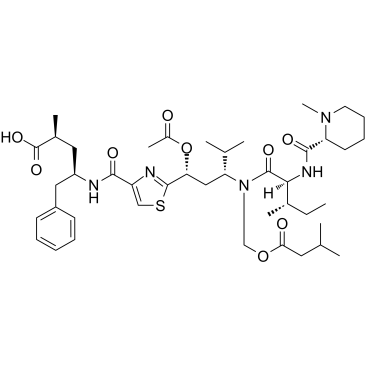Tubulysin D |
| Catalog No.GC37838 |
La tubulysine D est l'un des dérivés les plus puissants parmi les tubulysines isolées des espèces myxobactériennes Archangeum geophyra et Angiococcus disciformis. La tubulysine D est un nouveau tétrapeptide qui affiche une puissante activité antitumorale et conduit À l'arrêt du cycle cellulaire et À l'apoptose en inhibant la polymérisation de la tubuline avec une IC50 de 1,7 μM. La tubulysine affiche une activité cytotoxique extrêmement puissante dans les cellules de mammifères, y compris les lignées cellulaires multirésistantes, avec des valeurs IC50 dans la gamme nanomolaire inférieure.
Products are for research use only. Not for human use. We do not sell to patients.

Cas No.: 309935-57-7
Sample solution is provided at 25 µL, 10mM.
Tubulysin D is one of the most potent derivatives among the tubulysins isolated from the myxobacterial species Archangium geophyra and Angiococcus disciformis. Tubulysin D is a novel tetrapeptide that displays potent antitumor activity and leads to cell cycle arrest and apoptosis by inhibiting tubulin polymerization with an IC50 of 1.7 μM[1]. Tubulysin displays extremely potent cytotoxic activity in mammalian cells, including multidrug-resistant cell lines, with IC50 values in the lower nanomolar range[2]. IC50: 1.7 μM (Tubulin)[1]
Tubulysin D has IC50s of 4.7 pM, 3.1 pM, 670 pM and 13 pM for HL60, HCT116, MCF7, A549 cell lines antiproliferative activity, respectively[1].
[1]. Shibue T, et al. Synthesis and biological evaluation of tubulysin D analogs related to stereoisomers of tubuvaline. Bioorg Med Chem Lett. 2011 Jan 1;21(1):431-4. [2]. Kubicek K, et al. The tubulin-bound structure of the antimitotic drug tubulysin. Angew Chem Int Ed Engl. 2010 Jun 28;49(28):4809-12.
Average Rating: 5 (Based on Reviews and 23 reference(s) in Google Scholar.)
GLPBIO products are for RESEARCH USE ONLY. Please make sure your review or question is research based.
Required fields are marked with *




















